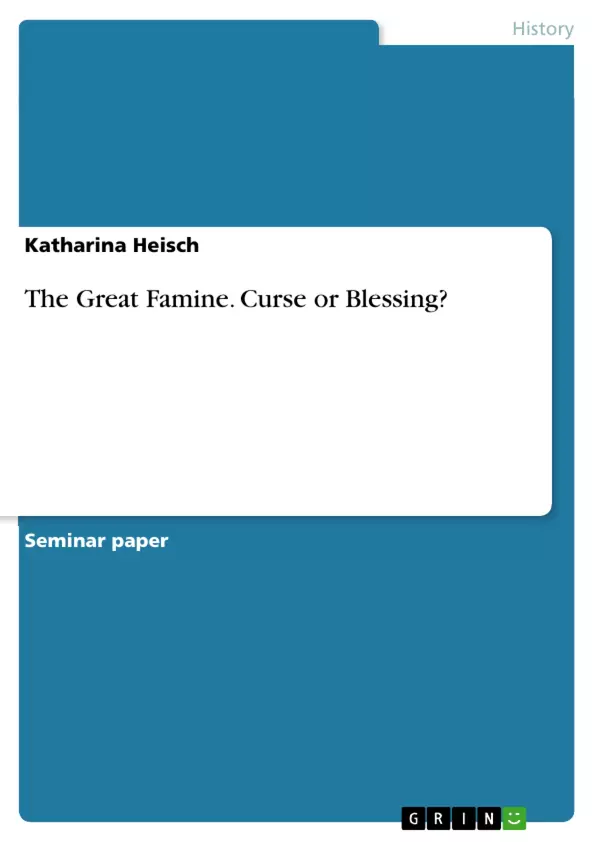A famine has multiple different effects on a country. Firstly an impression of the land before the dearth is given and reasons why the famine happened are pointed out. In this work it will be explained how Ireland changed due to hunger, discussing the negative and positive, short- and longterm consequences of the Great Famine. The actions to end the hunger by politicians and private individuals will also be discussed. At the end of this work I will form my opinion and answer the question as to whether the Great Famine was a curse or a blessing.
Inhaltsverzeichnis (Table of Contents)
- Introduction
- 1 Ireland Before the Famine
- 1.1 Population Growth
- 1.2 Dependence on the Potato Crop
- 2 The Beginning of the Great Famine
- 3 The Famine Years and Relief Approaches
- 3.1 Political Reforms
- 3.2 Workhouses and Soup Kitchens
- 3.3 Private Charity
- 4 Consequences
- 4.1 Diseases and Mortality
- 4.2 Evictions
- 4.3 Emigration
Zielsetzung und Themenschwerpunkte (Objectives and Key Themes)
This work aims to explore the multifaceted impacts of the Great Famine on Ireland, examining both its negative and positive consequences. It will delve into the factors that led to the famine, the various relief efforts implemented, and the long-term effects on the Irish population.
- Population Growth and Overdependence on the Potato Crop
- The Role of British Policies and Land Ownership
- The Impact of the Potato Blight and its Spread
- The Diverse Relief Measures Implemented during the Famine
- The Long-Term Consequences of the Famine on Irish Society
Zusammenfassung der Kapitel (Chapter Summaries)
- Introduction: This chapter provides an overview of the Great Famine, its historical significance, and its lasting impact on Ireland. It also highlights the devastating consequences of famines on vulnerable populations.
- 1 Ireland Before the Famine: This chapter examines the demographic and economic conditions in Ireland leading up to the famine, highlighting the rapid population growth and the overdependence on the potato crop. It also discusses the role of British policies and land ownership in shaping Ireland's socio-economic landscape.
- 2 The Beginning of the Great Famine: This chapter focuses on the emergence of the potato blight, its impact on the potato crop, and the devastating consequences for Irish farmers and peasants. It explores the spread of the blight and its role in triggering the famine.
- 3 The Famine Years and Relief Approaches: This chapter examines the various relief efforts implemented during the famine years, including political reforms, the establishment of workhouses and soup kitchens, and the role of private charity. It analyzes the effectiveness of these measures and their impact on the Irish population.
- 4 Consequences: This chapter explores the devastating consequences of the famine on Irish society, including the widespread diseases and mortality, forced evictions, and mass emigration. It analyzes the long-term effects of the famine on Ireland's social, economic, and cultural landscape.
Schlüsselwörter (Keywords)
The Great Famine, Ireland, Potato Blight, British Policies, Land Ownership, Population Growth, Overdependence, Relief Efforts, Workhouses, Soup Kitchens, Diseases, Mortality, Evictions, Emigration, Long-Term Consequences.
- Citar trabajo
- Katharina Heisch (Autor), 2016, The Great Famine. Curse or Blessing?, Múnich, GRIN Verlag, https://www.grin.com/document/356802



